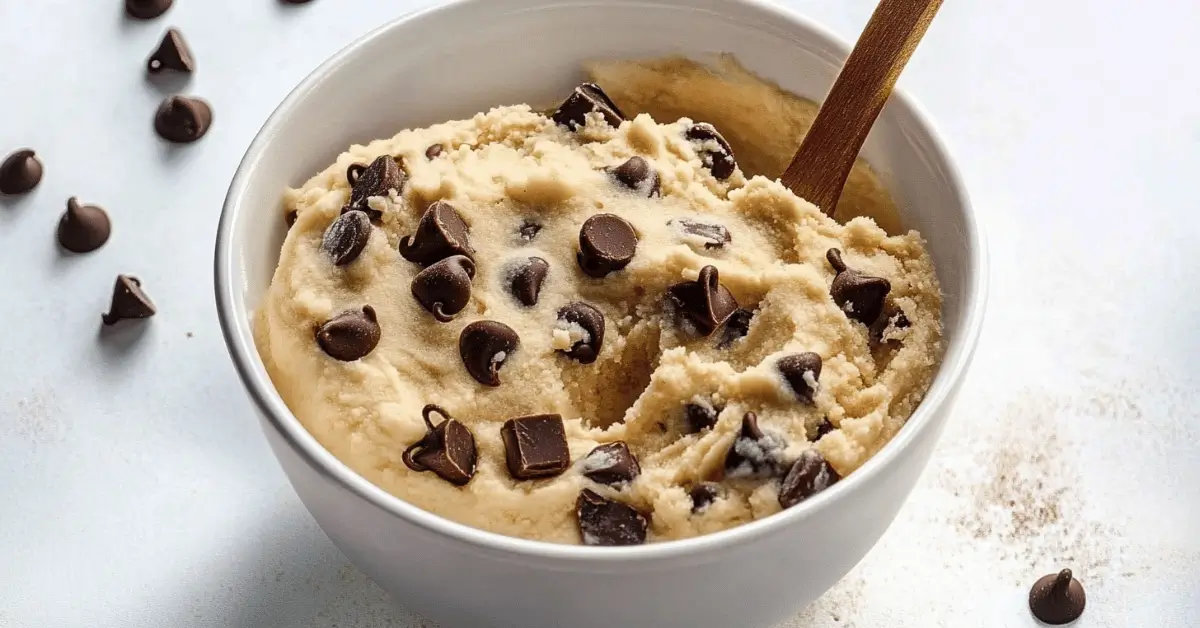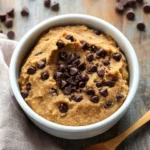Finding a dessert that tastes like a cheat but works like a fitness booster is rare. That’s where the protein cookie dough recipe steps in. Whether you’re someone counting macros, building lean muscle, or just craving a sweet snack that doesn’t wreck your diet, this edible cookie dough delivers. Packed with protein, free from raw eggs, and endlessly customizable, it’s the ultimate no-bake indulgence for healthy eaters and gym-goers alike.
In this article, we’ll break down exactly how to make your own protein cookie dough at home. You’ll learn which ingredients work best, how to adjust the recipe for different diets (keto, vegan, gluten-free), and the tricks to make it taste just like traditional dough. Plus, we’ll cover storage, safety tips, and answer the most asked questions about this guilt-free snack.
Looking for inspiration? Try this ghost protein ball recipe from our protein-packed collection.
Jumo to:
Why Protein Cookie Dough is the Perfect Healthy Treat
The Rise of High-Protein Desserts in Fitness Communities
The health and fitness world has seen a major shift. Protein is no longer just for shakes and post-workout meals. High-protein desserts like the protein cookie dough recipe have carved out a spot as a fun, functional treat that keeps cravings in check without compromising goals.
Fitness influencers and nutritionists alike rave about these sweet alternatives. They allow you to indulge while still meeting your daily protein intake. Instead of reaching for processed sweets, this homemade option offers whole ingredients with real benefits.
How This Recipe Balances Health, Flavor, and Convenience
What sets this recipe apart from traditional cookie dough or packaged protein snacks is its unbeatable trio: taste, nutrition, and ease. You can whip it up in under 10 minutes, using ingredients already in your pantry.
By using clean, high-quality ingredients—like nut butter for healthy fats, oats or almond flour for fiber, and your favorite protein powder—you create a treat that’s not only satisfying but also sustains your energy. It’s perfect for mid-day snacking, pre/post-workout fuel, or even as a dessert that doesn’t derail your progress.
Don’t miss our protein cookies with milk powder for another fantastic post-gym snack.
Ingredients That Make This Protein Cookie Dough Irresistible
Essential Base Ingredients: Nut Butters, Flours, and Sweeteners
What makes a protein cookie dough recipe truly stand out? It all begins with the base. These foundational ingredients create the structure, texture, and sweetness of your dough—without requiring any baking.
Let’s break them down:
| Ingredient | Purpose | Best Options |
|---|---|---|
| Nut Butter | Adds richness, healthy fats | Peanut, almond, or cashew butter |
| Flour Substitute | Provides structure | Oat flour, almond flour, or coconut |
| Sweetener | Balances out protein taste | Maple syrup, honey, or monk fruit |
| Milk or Milk Sub | Smoothens and binds the mixture | Almond milk, oat milk, or dairy milk |
Nut butter is the MVP here—especially when paired with almond or oat flour. It brings creaminess and a slightly salty kick that cuts through the sweetness just right. Want a paleo twist? Swap in cashew butter and coconut flour.
For sweeteners, stick with unrefined options or zero-calorie alternatives if you’re cutting sugar. The right combination of flour and liquid is what transforms this from gritty protein mush into silky, scoopable dough.
Check out our almond flour crepes if you’re already in love with almond-based recipes!
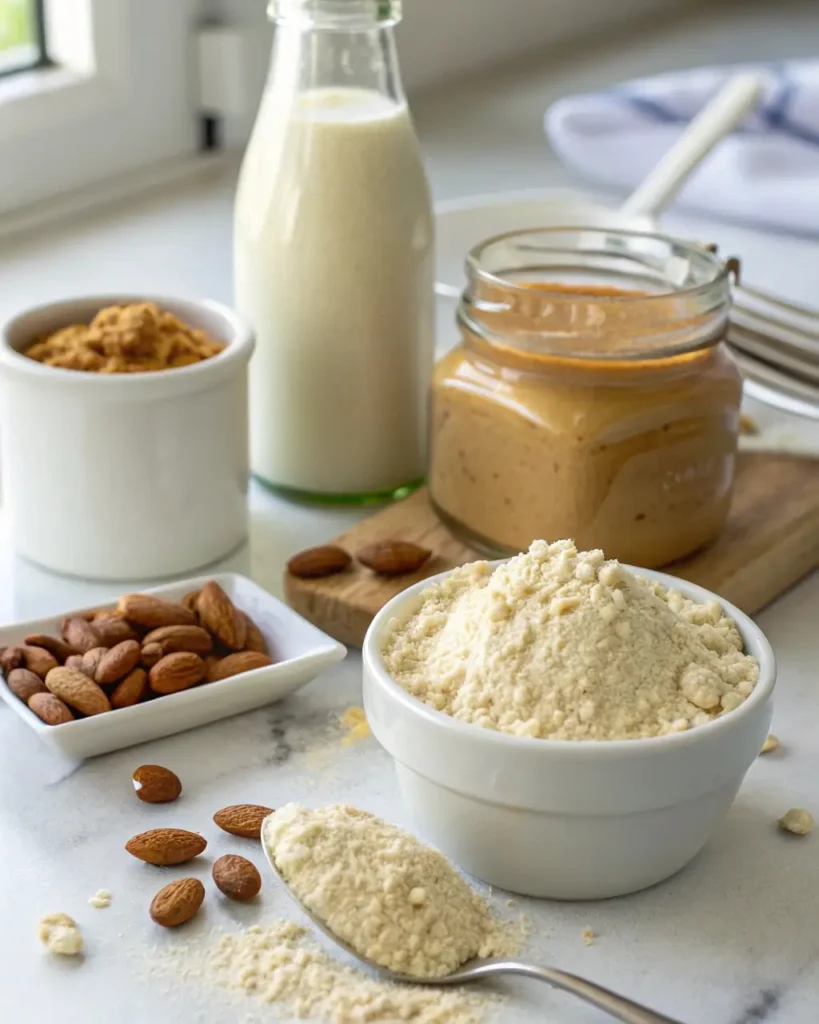
Choosing the Best Protein Powder for Your Dough Texture and Taste
Not all protein powders behave the same in a protein cookie dough recipe. The one you choose affects everything—from texture to flavor to mixability.
Here’s a quick guide to choosing the right one:
| Type of Protein | Texture Impact | Flavor Notes |
|---|---|---|
| Whey Isolate | Smooth and creamy | Mild, blends easily with flavors |
| Casein | Thick and dense | Adds chewiness |
| Plant-Based | Slightly grainy | Earthy or nutty tones |
| Collagen | Light, non-clumping | Neutral flavor, ideal for mixing |
For chocolate-based recipes, a chocolate or brownie-flavored whey isolate is a no-fail option. If you prefer vanilla or peanut butter flavors, a plant-based vanilla protein with almond butter is a dreamy combo.
Want to switch it up? Try using cookie butter protein powder for dessert-level indulgence. We used it here in this creamy cookie butter recipe.
A key tip: Always taste your dough before adding more sweetener. Some flavored proteins are already sweet enough, while others (especially vegan) might need a touch more maple syrup or vanilla extract.
How to Make the Perfect Protein Cookie Dough Recipe
Step-by-Step Guide to Mixing Your Dough Right the First Time
Making a delicious protein cookie dough recipe doesn’t require baking skills—it just needs the right order of operations and quality ingredients. Here’s a basic step-by-step formula to follow every time for creamy, scoopable results:
- Start with Dry Ingredients
In a mixing bowl, combine protein powder (1 scoop), flour substitute (like oat or almond flour), and a pinch of salt. This ensures even distribution before you add moisture. - Add Wet Ingredients
Pour in your choice of nut butter (2 tablespoons) and a liquid sweetener (like 1 tablespoon of maple syrup or honey). Add 1–2 tablespoons of milk or milk alternative to start binding the dough. - Mix Gently
Use a silicone spatula or spoon to combine everything. It’ll look dry at first—don’t panic. Keep folding. If it’s still crumbly after 60 seconds, add another teaspoon of milk and continue mixing. - Customize
Fold in chocolate chips, chopped nuts, or dried fruit. Even cinnamon or sea salt flakes can enhance the flavor. - Taste & Chill
Give it a quick taste test. Want it sweeter or smoother? Adjust accordingly. Once you’re happy, chill for 10–15 minutes. This helps the dough firm up and deepens the flavors.
Here’s a quick table overview for easy reference:
| Step | What to Do |
|---|---|
| 1 | Mix dry ingredients: protein, flour, salt |
| 2 | Stir in nut butter and sweetener |
| 3 | Add milk gradually while folding |
| 4 | Mix in add-ins (chocolate chips, nuts, etc.) |
| 5 | Taste and chill before serving |
Looking for more step-by-step dessert hacks? Don’t miss our protein rice krispies guide for another fun snack idea.
Common Mistakes to Avoid for Texture and Taste
Even the best protein cookie dough recipe can go south if you overlook the little things. Here are a few common missteps and how to fix them:
- Overusing protein powder
More isn’t always better. Too much protein makes the dough dry and chalky. Stick to 1 scoop (about 25–30g) per serving. - Not balancing wet-to-dry
If your dough is too wet or too crumbly, you likely didn’t measure flour or milk accurately. Always add liquid slowly and stop when you reach the desired consistency. - Using unflavored or bitter protein
Some proteins (especially budget brands) taste terrible without lots of masking. Go for a high-quality flavored protein that complements your dough theme. - Skipping the chill
Warm dough can feel greasy or sticky. Just 10 minutes in the fridge will improve texture and make scooping easier.
Want a baked option instead? Discover great ideas like our chewy molasses cookies—perfect for cozy vibes.
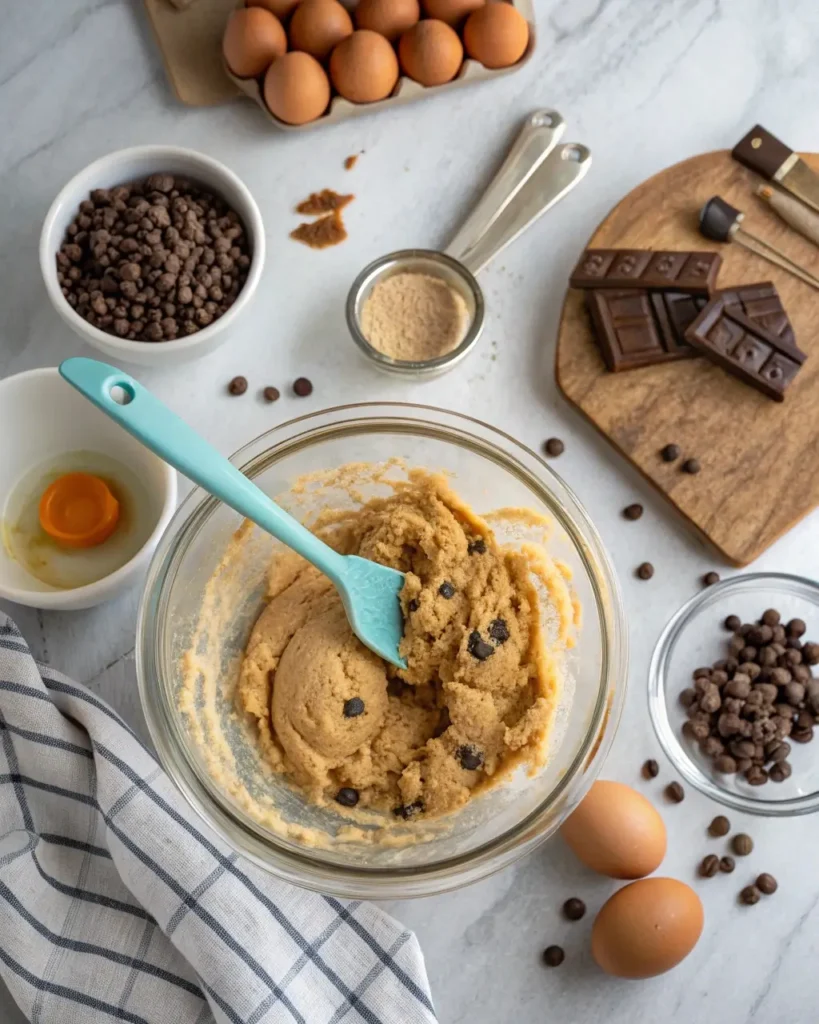
Best Protein Powders for a Perfect Protein Cookie Dough Recipe
Whey, Casein, Plant-Based, and Collagen – Which Protein Is Best for Cookie Dough?
If you’re crafting the ultimate protein cookie dough recipe, the type of protein powder you choose is everything. Each variety impacts the flavor, consistency, and overall mouthfeel of your edible cookie dough. Not all powders mix the same—so choosing wisely is key to nailing the best version of your protein cookie dough recipe.
| Protein Type | Texture | Perfect For… |
|---|---|---|
| Whey Isolate | Creamy, smooth | Classic cookie dough recipes |
| Casein | Dense and fudgy | Thick, filling protein cookie dough |
| Plant-Based | Slightly gritty | Vegan protein cookie dough recipe |
| Collagen Peptides | Light, subtle flavor | Blends into any cookie dough recipe |
- Whey isolate is most popular in any protein cookie dough recipe due to its smooth blendability and rich taste.
- Casein adds a thicker, cheesecake-like texture, ideal if you like your cookie dough extra indulgent.
- Plant-based protein is great for a dairy-free protein cookie dough recipe, but be aware—it can slightly alter the texture.
- Collagen blends well and is a solid choice if you want added health benefits while keeping flavor neutral.
Flavor Pairings That Make Your Protein Cookie Dough Recipe Irresistible
The success of your protein cookie dough recipe doesn’t just lie in macros—it’s about flavor. Matching the flavor of your protein powder to your mix-ins creates magic. Think chocolate protein with peanut butter and sea salt, or vanilla with cinnamon and white chocolate chips.
| Protein Flavor | Flavor Pairings for Cookie Dough |
|---|---|
| Chocolate | Cocoa powder, dark chocolate chips, peanut butter |
| Vanilla | Cinnamon, almond extract, white chocolate chips |
| Cookie Butter | Crushed graham, oat flour, maple syrup |
| Peanut Butter | Banana chips, chopped peanuts, pretzels |
When building your protein cookie dough recipe, stick with flavor combinations that work together. Don’t mix a bitter vegan chocolate protein with lemon zest—it’ll throw off the balance.
Need inspiration for a wild but tasty combo? Check out this cookies and cream protein cookie recipe — a fun twist to elevate your own protein cookie dough recipe.
How to Customize Your Protein Cookie Dough Recipe
Mix-Ins That Add Fun and Flavor to Any Protein Cookie Dough Recipe
A great protein cookie dough recipe is all about the extras. While your base recipe is delicious on its own, the real fun begins when you add personality. From texture to flavor, mix-ins help you tailor every batch.
| Add-In | Why It Works |
|---|---|
| Dark Chocolate Chips | Classic cookie dough texture and bold sweetness |
| Peanut Butter Swirl | Adds richness and boosts the protein punch |
| Coconut Flakes | Enhances texture and offers tropical flavor |
| Chopped Almonds | Crunch and healthy fats for your recipe |
| Cacao Nibs | Bitter notes that contrast sweet dough |
Fold these ingredients into your protein cookie dough recipe after mixing the base. This keeps the dough smooth and gives every bite a pop of flavor and crunch.
Looking to experiment? Try our jalapeño popper chicken for inspiration on combining bold flavors—even in dessert.
Vegan, Gluten-Free, and Low-Carb Protein Cookie Dough Variations
The best part about making your own protein cookie dough recipe at home? You can adjust it to match any dietary preference without sacrificing taste.
Vegan Protein Cookie Dough Recipe
- Use a plant-based protein
- Replace honey with maple syrup
- Almond, soy, or oat milk
- Add flax or chia seeds for texture
Low-Carb Protein Cookie Dough Recipe
- Use almond flour or coconut flour
- Sweeten with monk fruit or erythritol
- Avoid oats or sugars
- Choose keto-friendly mix-ins
Gluten-Free Protein Cookie Dough Recipe
- Stick to certified gluten-free oat or almond flour
- Avoid cross-contaminated protein powders
- Check mix-ins like chocolate chips for hidden gluten
Your customized protein cookie dough recipe can still be indulgent, delicious, and macro-friendly—just with a few smart swaps. Try using almond flour for structure and a vegan chocolate protein for a plant-based boost.
Don’t miss our roam diet recipes for more flexible eating ideas that align with your goals.
Is It Safe to Eat Protein Cookie Dough Raw?
Understanding Edible Dough vs Traditional Cookie Dough
When people hear “cookie dough,” their first concern is usually food safety. And rightly so—traditional cookie dough often contains raw eggs and untreated flour, both of which can carry foodborne bacteria like salmonella or E. coli.
But here’s the good news: a well-prepared protein cookie dough recipe is meant to be eaten raw. No eggs. No raw all-purpose flour. Just clean, edible ingredients that are safe straight out of the bowl.
Here’s what makes edible protein cookie dough totally safe:
| Unsafe Ingredient | Safe Alternative in This Recipe |
|---|---|
| Raw eggs | None (replaced with nut butters or flax) |
| Raw all-purpose flour | Oat flour, almond flour, or coconut flour |
By using heat-treated or naturally safe flours (like almond or oat) and skipping eggs altogether, your homemade dough is perfectly snackable.
Looking for more egg-free indulgence? Don’t miss our Paula Deen banana pudding—it’s just as rich without the risk.
How to Avoid Food Safety Issues with Smart Ingredient Choices
Even in egg-free recipes, there are a few safety tips to keep in mind, especially if you’re storing the dough or prepping it in bulk:
- Use nut butters that are stored properly and not expired. These provide fat and texture but can go rancid over time.
- Refrigerate any unused dough within two hours of mixing to keep it fresh.
- Wash your hands and mixing tools before starting to avoid cross-contamination.
- Store in an airtight container to preserve freshness and texture.
If you want to be extra cautious, you can toast your oat flour in a skillet for a few minutes to reduce any trace of bacteria—even though most store-bought versions are already heat-treated.
Need more safety tips for smart snacking? Learn how to make hamburger potato soup in safe, family-friendly ways.
Meal Prep, Storage & Shelf Life
How Long Protein Cookie Dough Lasts in the Fridge or Freezer
One of the best parts about making a protein cookie dough recipe is how well it stores. Unlike baked goods that go stale quickly, this no-bake treat stays soft, creamy, and delicious for days—making it perfect for meal prep or make-ahead snacking.
Here’s how long you can expect your dough to last:
| Storage Method | Shelf Life | Tips |
|---|---|---|
| In the fridge | 5 to 7 days | Use airtight containers, keep it sealed |
| In the freezer | Up to 3 months | Freeze in individual scoops or portions |
To store, simply scoop your dough into small glass jars, reusable silicone cups, or portion it out using a cookie scoop and freeze on a tray. Once frozen, you can transfer scoops to a sealed bag or container for easy grab-and-go treats.
Want a freezer-friendly snack idea? Don’t miss our chicken tortellini soup — it reheats beautifully just like frozen dough softens with ease.
Tips for Portioning and Storing for Easy Snacks
If you’re prepping dough ahead of a busy week, portion control can help you stay on track with your goals. Here are some smart ways to store and serve:
- Use a cookie scoop to divide dough into even 1–2 tablespoon servings.
- Label containers with date and flavor (especially if you make multiple batches).
- Refrigerate in layers using parchment paper between scoops to prevent sticking.
- Grab & go snack packs: Store individual scoops in mini snack cups or Ziplocs for work or gym bags.
You can even store some dough chilled and some frozen, so you’ve got options depending on your cravings or schedule.
Looking for a make-ahead meal with staying power? Try our ham and potato soup — another meal-prepper’s favorite.
Fun Ways to Serve Protein Cookie Dough
Protein Cookie Dough Bowls, Protein Ice Cream Mix-ins, and More
Your protein cookie dough recipe doesn’t have to be limited to a spoonful straight from the bowl—though let’s be real, that’s pretty satisfying. If you’re looking to elevate your snack game, try serving it in creative ways that double as desserts, breakfasts, or even high-protein party bites.
Here are some exciting serving ideas:
| Serving Style | How to Do It |
|---|---|
| Dough Bowls | Scoop into a small bowl, top with fruit, dark chocolate, or coconut flakes |
| Ice Cream Mix-In | Swirl chilled dough into protein or Greek yogurt-based ice cream |
| Dough Truffles | Roll into balls, chill, and coat with melted chocolate or cocoa powder |
| Stuffed Dates | Fill pitted dates with a spoon of cookie dough for a sweet bite |
| Waffle or Pancake Topping | Drop dough on warm pancakes for melty, gooey deliciousness |
These ideas turn your protein cookie dough recipe into a versatile component of other meals or treats. You can even serve it on toast with sliced bananas or pair it with a protein shake for a double boost.
Want more snack-style recipes like this? Explore our chicken tortilla soup (crock pot version) for another make-ahead option that’s great for any time of day.
Creative Ways to Use Leftover Dough in Baked Recipes
Got leftovers? Instead of letting your protein cookie dough sit in the fridge for a week, try baking with it. Yes, you can turn your no-bake recipe into baked cookies or protein bars with just a few tweaks.
Here’s how:
- Mini Cookies: Flatten scoops of dough on a baking sheet and bake at 325°F for 8–10 minutes
- Protein Blondies: Press dough into a lined loaf pan and bake for 12–15 minutes
- Oat Cups: Mix dough with rolled oats and a splash of milk, press into muffin tins, and bake
Be sure your dough uses a heat-stable protein (like whey or casein) and doesn’t contain ingredients that separate when heated (like some coconut oils).
For baking fans, don’t miss our cake mix banana bread — the perfect way to use pantry staples for warm, baked comfort.
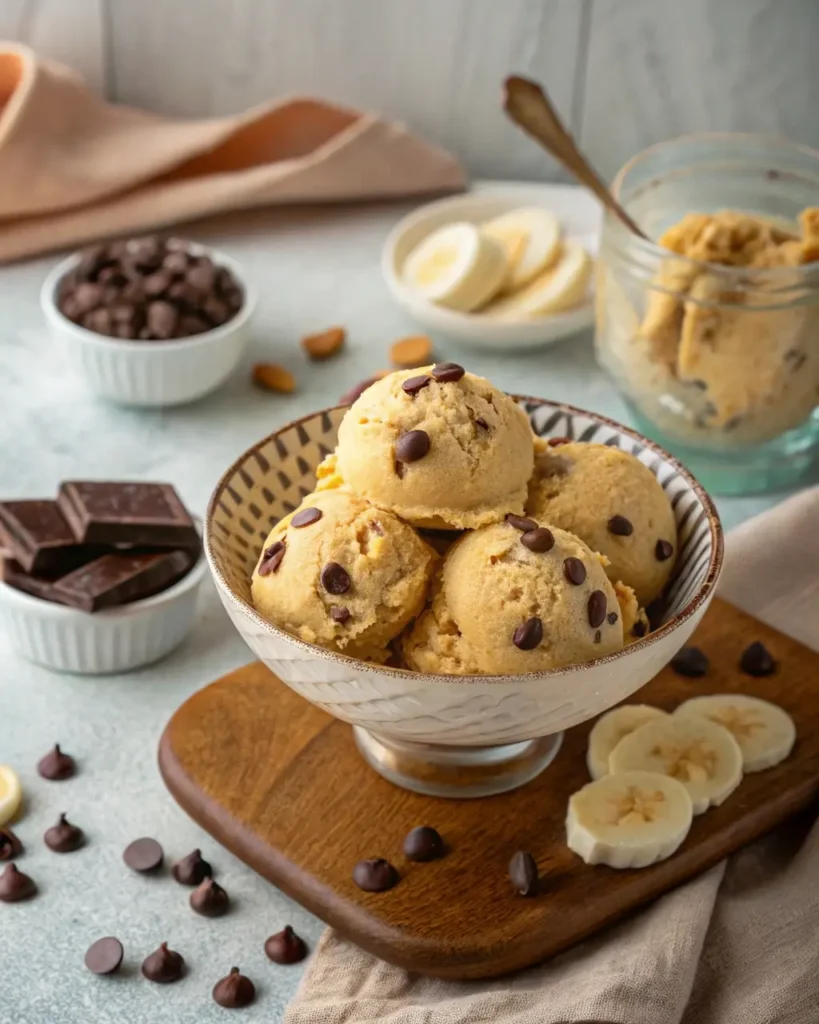
Nutritional Breakdown and Benefits
Calorie and Macro Profile of Typical Protein Cookie Dough
One of the biggest advantages of a protein cookie dough recipe is that it satisfies your sweet tooth while still supporting your nutrition goals. Whether you’re cutting, bulking, or just eating smart, knowing what you’re putting in your body matters.
Here’s a typical macro breakdown for one serving (approx. 2 tablespoons) of homemade protein cookie dough:
| Nutrient | Amount (Per Serving) |
|---|---|
| Calories | 180–220 |
| Protein | 12–18g |
| Carbohydrates | 8–14g (can be lower for keto) |
| Fat | 8–12g (from healthy sources) |
| Sugar (natural) | 2–6g |
| Fiber | 3–5g |
Note: Macros vary depending on the protein powder, nut butter, and flour you use. Always check your labels if you’re tracking!
This balance of protein, fiber, and healthy fat makes it ideal as a muscle-repair snack post-workout or a mini-meal to crush hunger between meals.
Looking for other macro-friendly recipes? Check out our beef barley soup for a hearty and filling option that aligns with clean eating goals.
How It Supports Muscle Gain, Recovery, and Healthy Snacking
This protein cookie dough recipe isn’t just a fun snack—it’s a functional one. Here’s how it benefits your body:
- Muscle Recovery: High protein content helps rebuild muscle fibers after training.
- Sustained Energy: Healthy fats from nut butter keep you full longer and prevent crashes.
- Gut-Friendly: When made with collagen or prebiotic-rich ingredients like oats or flax, it aids digestion.
- Sugar Control: Homemade dough lets you skip the added sugars found in store-bought protein bars.
It’s also a perfect swap for late-night sweet cravings. Instead of diving into sugary cookies or ice cream, one scoop of this dough hits the spot—without the guilt.
Looking for another high-protein comfort food? Don’t miss our chicken tenders and fries for a guilt-free take on a classic.
Frequently Asked Questions
Is protein cookie dough safe to eat raw?
Yes! Unlike traditional cookie dough, this protein cookie dough recipe is specifically made to be eaten raw. It skips unsafe ingredients like raw eggs and untreated flour. Instead, it uses safe-to-eat alternatives like oat flour, almond flour, and nut butter, making it a perfect no-bake treat.
What protein powder works best for edible cookie dough?
Whey isolate and casein are top picks for their smooth texture and rich flavor. For vegan or dairy-free options, go with a quality plant-based protein made from peas or brown rice. Always choose flavored powders that complement your dough (vanilla, chocolate, peanut butter, etc.).
Can I make a vegan protein cookie dough recipe?
Absolutely. To make your protein cookie dough recipe vegan, use plant-based protein powder, maple syrup or agave instead of honey, non-dairy milk, and nut butters like almond or peanut. You’ll still get a rich, creamy texture with great macros.
How can I make a low-carb version of protein cookie dough?
Swap traditional oats or flours with almond flour or coconut flour, use a sugar-free sweetener like monk fruit, and make sure your protein powder is low in carbs. Stick to keto-friendly add-ins like unsweetened coconut, nuts, or sugar-free chocolate chips.
How long does protein cookie dough last in the fridge?
When stored in an airtight container, this protein cookie dough recipe lasts 5 to 7 days in the refrigerator. If you want to make it last longer, freeze individual scoops and enjoy for up to 3 months.
Can I bake protein cookie dough into cookies?
Yes! While this dough is designed to be eaten raw, you can bake it into small cookies or bars. Just make sure to use a heat-stable protein (like whey), and bake at 325°F for 8–12 minutes depending on size. The texture will be softer than traditional cookies but still delicious.
Conclusion
The beauty of a well-crafted protein cookie dough recipe lies in its simplicity, flexibility, and nutrition. Whether you’re trying to crush cravings, boost your post-workout recovery, or just enjoy a guilt-free dessert, this edible dough delivers on all fronts. It’s easy to prep, endlessly customizable, and fits a variety of dietary needs—vegan, keto, gluten-free, and everything in between.
By choosing the right ingredients—like clean protein powders, natural sweeteners, and healthy fats—you can make a snack that satisfies both your sweet tooth and your macros. Plus, with its long shelf life and no-bake nature, it’s perfect for busy lifestyles and weekly meal preps.
So go ahead—grab that scoop. You’re not just indulging; you’re nourishing your body with every bite.
Don’t miss our other creative, protein-packed recipes like chicken and shrimp stir fry—a savory way to balance your weekly menu.
PrintProtein Cookie Dough Recipe
This protein cookie dough is a quick, healthy snack that’s easy to make. Packed with 30g of protein, it’s flourless, egg-free, and customizable to your taste!
- Prep Time: 10 minutes
- Total Time: 10 minutes
- Yield: 4 servings
- Category: Snack, Dessert
- Method: No-Bake
- Cuisine: American
- Diet: Gluten Free
Ingredients
- 1 scoop (30g) protein powder (vanilla, chocolate, or unflavored)
- 1/4 cup almond flour or oat flour
- 2 tbsp peanut butter or almond butter
- 1–2 tbsp honey or maple syrup
- 2–3 tbsp almond milk or water
- 1/4 cup dark chocolate chips or cacao nibs (optional)
- Optional: 1 tsp vanilla extract, pinch of sea salt
Instructions
- Mix protein powder, almond flour, and optional dry ingredients in a bowl.
- Add peanut butter, honey, and vanilla extract, stirring to combine.
- Gradually add almond milk, one tablespoon at a time, until the dough reaches your desired consistency.
- Fold in chocolate chips or your favorite add-ins.
- Serve immediately or store in the refrigerator.
Notes
- Adjust sweetness with more or less honey/maple syrup.
- For a firmer dough, add extra almond flour.
- Store in an airtight container for up to 1 week.

